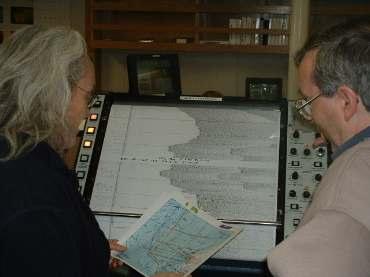1 February, 2004
We had completed using the single channel streamer sometime during
the night and we were now towing the multichannel streamer. We were
using two air guns rather than the larger six gun array that we had
used in the open water. There was still concern about the ice
damaging the streamer, but there was a high degree of comfort among
the scientists and marine techs that the ice that we would encounter
today would not be a big factor. We were adding shot lines to
supplement ones that we had shot yesterday. Using the multichannel
streamer produces data that has much greater resolution making it
easier for the scientists to identify and recognize features in the
crust.
The scientists are able to view the seismic data in real time by
looking at a thermal plotter that is generally called the "EPC" on
the ship. The EPC looks like a picture made of thin lines and
squiggles. To the geophysics patterns represent folded regions of
rock in the crust, volcanic features, faults, or other more
complicated structures. The trained eye can quickly recognize an
unusual feature, and then there is often a conference of the minds
where ideas are shared and hypotheses are hatched. Over the last few
days there have been many conferences over the EPC as the scientists
discussed their observations and used the plots to select new shot
lines that would give them more information about the direction and
size of the features that they observed.
It takes days to formally process the data. The data is collected
and stored with time and geographic data encoded with it. These
files are saved as the data is collected and the organized by the
time they were collected. All the time information is recorded using
GMT, Greenwich Mean Time, which is thirteen hours behind ship time.
At midnight GMT each day the data is backed up for permanent storage.
Twenty four hours later, the data can be processed using special
computer software to get a more detailed look at the data. When the
scientist leave the ship their will take the data with them and this
will be the basis for published papers and further research by them
and others for many years.
The weather has been glorious, clear and with light winds. A strong
wind to the north would help move some of the fast ice out past B15A
and B15K, but that doesn't appear to be in the forecast. Through the
morning, the ship has been making parallel shot lines that start on
the ice edge on Ross Island and extend to the eastern ice edge of
McMurdo Sound.
As we approach the ice edge, it is not unusual to see pods of Orcas
moving up and down the edge. The ship's navigators are always
careful to keep the whales at a distance much greater than the
protective radius for marine mammals when we have air guns in the
water for seismic. At about 9:00 AM ship time, we entered fresh
clear sea ice about one to three inches thick. The only open water
was at the edge of the old sea ice and in the wake of the ship. As
we approached the old ice, a pod of six Orcas was sighted. They were
well out of range, so we just kept track of them. As the ship began
its turn, the Orcas appeared to move toward the open water in our
wake. Within minutes, we had whales within the protective zone and
the MPC; Ashley Lowe was contacted and firing of the guns stopped.
Everyone rushed to the decks to see the whales since they were so
close.
Little did we know on bridge, a problem had occurred with the
computer data logging system, and not only were we not collecting
seismic data because of the whales, no data would be collected for
about thirty minutes until the computer system was online again. The
electronics and network staff kept the scientists informed of what
was going on as they made a quick restart of the system. The
scientists decided to pull in the streamer, for the time being. We
would continue to do multibeam sidescan sonar for the remainder of
the day.
As we traveled back and forth across the sound we had spectacular
views of Ross Island and the east coast of McMurdo Sound. Our course
took us so close to the cost of Ross Island that it was easy to
identify Shackleton's Hut. Shackleton was a British explorer who
attempted many Antarctic firsts. He is known for his attempted
Antarctic crossing from the Weddell Sea on the west coast to Ross
Island on the east. During the expedition, the ship was trapped in
the sea ice and destroyed. He and his crew were able to make it to
Elephant Island where he and a rescue party eventually made an 800
mile crossing to South Shetland Island were a rescue ship was
secured. After about two years the crew was rescued. All members of
the crew survived.
From the ship, we could see the red coats of visitors as they looked
around outside of the hut. The hut is a historical site, and efforts
have been made in recent years to make historically appropriate
repairs to the structure that has occurred over the years.
--

Terry Wilson and Stuart Henrys discuss the preliminary plot of the single channel seismic data.

Orcas surfacing between the sea ice and the ship.

Shackelton's hut as seen from McMurdo Sound. --

Contact the TEA in the field at
.
If you cannot connect through your browser, copy the
TEA's e-mail address in the "To:" line of
your favorite e-mail package.
|
